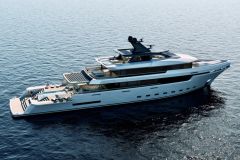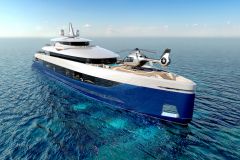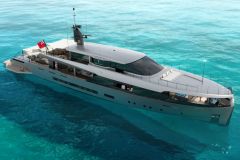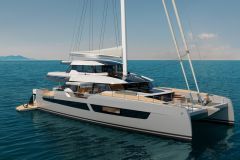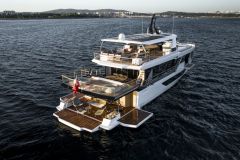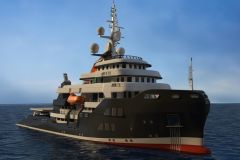Succeeding the royal ship Victoria and Albert
Before the conception of Britannia, its predecessor Albert and Victoria was the first royal yacht not to be powered by sail. Built for Queen Victoria, she never set foot on board, concerned about the stability of the vessel. King Edward VII sailed on board several times, mainly in the Mediterranean. Having served 4 sovereigns in 38 years and not having left Europe since 1911, the Victoria and Albert was decommissioned in 1939 and demolished at Faslane (Royal Navy base) in 1954.
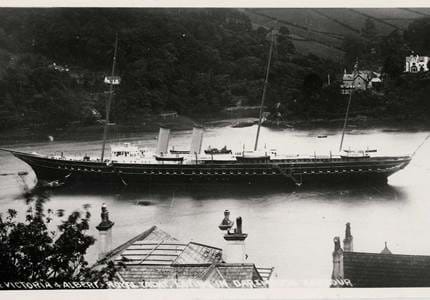
A royal yacht, but also a hospital ship
In 1938, the Admiralty (the political and administrative body managing the Royal Navy) considered the possibility of building a new ship. It was decided to build a new royal yacht, which could both travel the world and serve as a hospital ship in times of war. This project was initiated by King George VI, who was very interested in the design. The latter was ill and it was thought that a convalescent cruise on board this new ship would help the King's fragile health. The project was launched and specifications were sent in 1939 to the main shipbuilders of the country at the time. But the advent of the war brought the project to a halt.
This one was relaunched in 1951 on the basis of the 1939 design, but in a smaller size. This new hospital ship was integrated into the rearmament program and used in peacetime as a royal ship. She was the first royal yacht to offer ocean-going capability, capable of sailing in both tropical and Arctic waters, with a continuous speed of 21 knots and a range of 2,000 miles at 20 knots. For cost savings, the displacement is set at 4euros000 tons and the size at 312 feet (95 m).
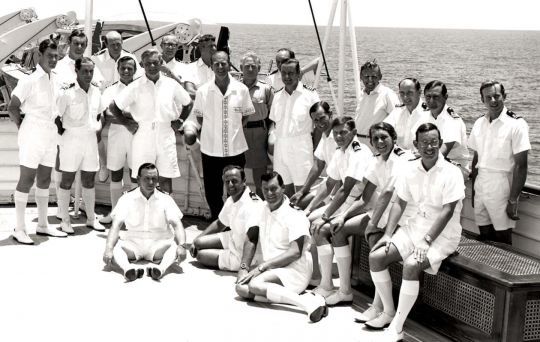
Designing a dual-purpose ship is not easy. Some features add value to a royal ship without being essential. They do, however, become essential in the case of a hospital ship. For example, stabilizers, air conditioning units and a large laundry are installed.
As a royal ship, the "White Ensign" (white flag of the White Squadron of the Royal Navy represented by a red cross on a white background with a Union Jack) had to appear on the ship. It was then led by a professional crew. In its 2nd function, the ship was then to fly the "Red Ensign" (red flag) and be operated by a merchant service crew.
As a hospital ship, the ship must be able to accommodate 200 patients in the aft section. While the majority of patients are medical and surgical cases requiring normal hospital conditions, provision must be made for zymotic diseases (acute infections) and tuberculosis. The former will be accommodated in glass cabins built in the lounge with adequate sanitary facilities and isolated from the rest of the ship. Tuberculosis cases requiring "fresh air" will be accommodated in a part of the veranda deck. There will also be an operating room, adjacent sterilization and anesthesia rooms, as well as specialized services such as an ophthalmology room, a physiotherapy room, a pathology laboratory and a radiology room with adjacent darkroom. Full dental facilities, including a laboratory, will be located on the main deck. For the care and treatment of patients, the Navy's medical staff will include eight physicians and dentists, five nurses and 47 sailors.
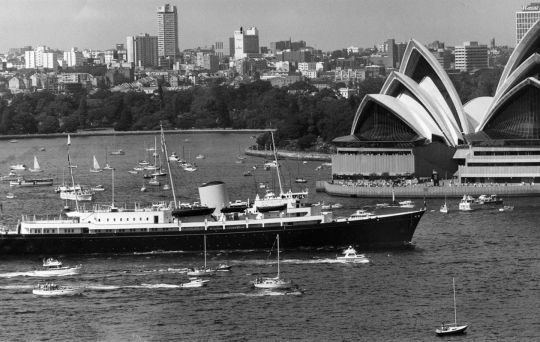
A modern look, a sumptuous design
Britannia's appearance is modern for its time, with a clipper bow and a cruiser stern, a design preferred to the old traditional royal yacht design. She has three masts, as do all royal yachts. The Royal Standard is carried on the main mast, the Lord Admiral's flag on the bow and the Union Flag on the mizzen mast. The aft superstructure is slightly larger than desired from an aesthetic point of view. This architecture allows the installation of the royal and state apartments, as well as the living spaces dedicated to the royal staff. The crew will be housed on the bow. The ship also features a main staircase, an elevator, guest cabins, several kitchens, large reception rooms, prestigious dining rooms
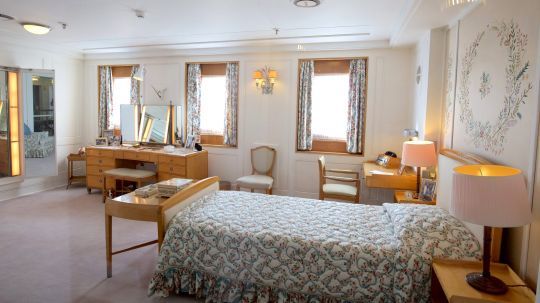
The main dining room is the grandest of Britannia's living spaces. The Queen and the Duke of Edinburgh have hosted some of the world's most powerful people here: Sir Winston Churchill, Nelson Mandela, Ronald Reagan and Margaret Thatcher. The aft deck area allows the royal family to relax in the sun, playing shuffleboard or field hockey, treasure hunts, water fights. Prince Philip sometimes set up his painting easel here and a free standing pool allowed the royal family to bathe if they wished. The foredeck hosted plays or concerts for the pleasure of the crew and all the people on board. The spacious and elegant saloon served as both a place for the royal family to relax and as a reception room, accommodating up to 250 guests.

Britannia was also the only ship of the Royal Navy to have a permanent laundry on board. The 250 crew members (including 21 officers) could change their uniforms up to 6 times a day. Thus, the washing machines, dryers and steam presses were in constant operation. There was also a NAAFI store on the ship, so that everyone could stock up with whatever they were looking for, from toothpaste to souvenir gifts.
2 years of construction and reliability
7 builders were in the running to win the contract. Finally, the John Brown & Co shipyard in Clydebank, Scotland received the order for this new ship on February 4, 1952. It is one of the most famous shipyards in the world, having built the famous liners Queen Elizabeth and Queen Mary.
Unfortunately, King George VI, Queen Elizabeth's father, never saw the bow of the ship as he died two days later. His daughter succeeded him on the throne and took over the construction of the ship. Among the requirements, the ship had to be completed by the end of 1953 or early spring 1954 at the latest. A complicated deadline given the shortage of materials in these post-war times. The keel was laid on June 16, 1952, and the ship was launched on April 16, 1953.
The name of the ship remained a secret until the Queen broke a bottle of Empire wine (champagne was considered too extravagant in post-war Britain) and announced "I name this ship Britannia. I wish her success and all those who will sail on her."
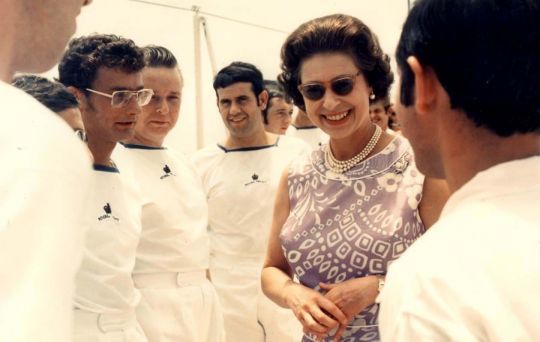
Work continued for some time, including the installation of the chimney and masts. Sea trials began on November 3, 1953 off the west coast of Scotland. Britannia was commissioned by the Royal Navy on January 11, 1954.
On April 22, Britannia made her first sail across the Channel to Malta. For 44 years, she sailed the equivalent of a round-the-world voyage each year, calling at more than 600 ports in 135 countries, including the United States, Australia, Canada and New Zealand. Her fuel tank of 330 tons and her fresh water tank of 120 tons could be increased to 490 tons and 195 tons respectively for long voyages, but remained mostly empty.
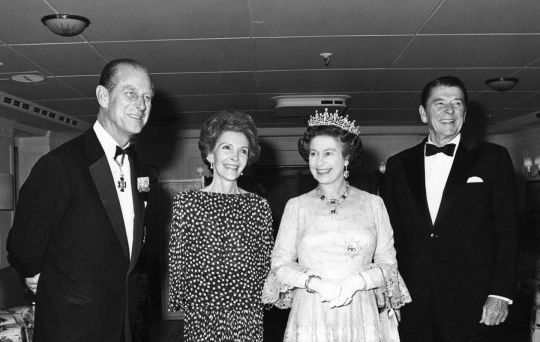
A ship to represent England
For 44 years, Britannia served both as a royal residence to host state visits (968) and official receptions, but also as a haven for family vacations. It will also be the witness of 4 royal honeymoons, the ambassador of British business, promoting trade and industry around the world or involved in the evacuation of British nationals during the Yemen war in 1986.
Her decommissioning in 1997 marked the end of a long tradition of British royal yachts, which began in 1680 during the reign of Charles II. She is the last ship of a fleet of 83 British royal yachts. Today Britannia no longer sails, but can be visited and hosts a hotel-restaurant. She also hosts many events.
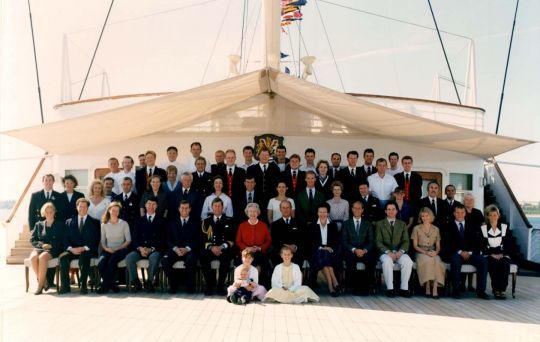

 /
/ 


